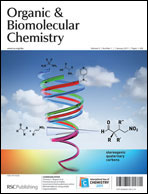Various methoxy- and hydroxy-substituted dibenz[c,e]oxepines were prepared via the copper(I)-induced coupling of ether-tethered arylstannanes or the dehydrative cyclisation of 1,1′-biphenyl-2,2′-dimethanols, assembled using the Ullmann cross-coupling of ortho-bromoaryl carbonyl compounds. The dibenzoxepines were screened for their ability to inhibit tubulin polymerisation and the in vitrogrowth of K562 human chronic myelogenous leukemia cells. The most active was 5,7-dihydro-3,9,10,11-tetramethoxydibenz[c,e]oxepin-4-ol, whose tubulin inhibitory and cytotoxicity (IC50) values were 1 μM and 40 nM, respectively.
You have access to this article
 Please wait while we load your content...
Something went wrong. Try again?
Please wait while we load your content...
Something went wrong. Try again?
![Graphical abstract: Tubulin-binding dibenz[c,e]oxepines as colchinol analogues for targeting tumour vasculature](/en/Image/Get?imageInfo.ImageType=GA&imageInfo.ImageIdentifier.ManuscriptID=C0OB00500B&imageInfo.ImageIdentifier.Year=2011)

 Please wait while we load your content...
Please wait while we load your content...